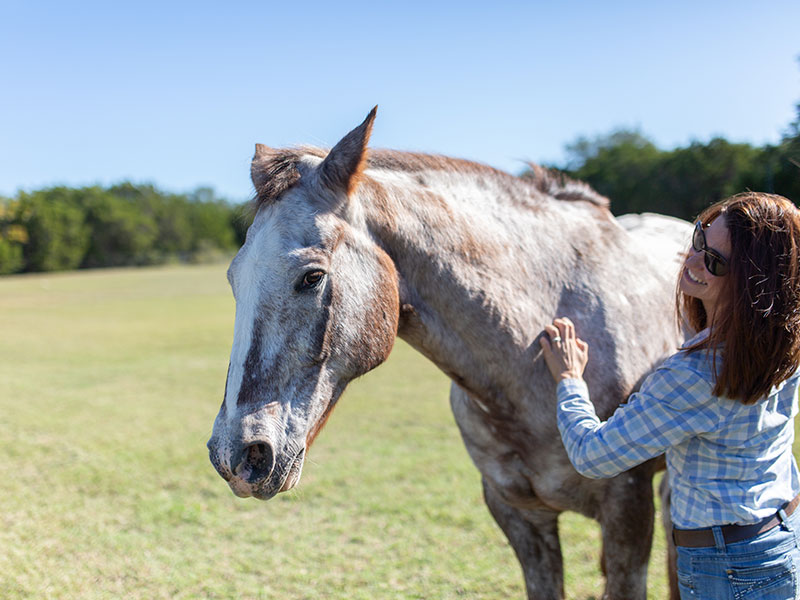Cedar Crest Hospital & Residential Treatment Center helps individuals who are struggling with opiate addiction find long-term recovery. Located in Belton, TX, Cedar Crest is the leader in mental health care.
Understanding Opiate Addiction
Learn about opiate addiction
When pain is associated with a chronic condition that cannot be treated by standard over-the-counter medications like acetaminophen, such as cancer, physicians often prescribe opiate narcotics such as Vicodin or OxyContin. Most people who are prescribed these central nervous system depressant analgesics do not have a problem using them the way in which they were prescribed and then go on about their life without any problems. However, some people may be drawn to the feelings of euphoria and overall wellbeing these drugs create.
Opiate abuse occurs when an individual uses these narcotics for non-medical purposes in a way not intended by the prescribing doctor. This type of prescription pain killer abuse is becoming a major problem in the United States and worldwide. People who abuse prescription opiates run the risk of very serious health complications and increasing interpersonal problems, and may abuse these drugs by orally ingesting them, crushing them and snorting them, or liquefying the drug and injecting it into the vein or muscle. While no one goes to the doctor for pain relief with the idea of becoming an addict, people who abuse opiates can quickly develop a tolerance to the drugs, needing more and more to achieve the same the initial effect. While addiction can slowly take over a person’s life, with the proper detox, rehab, and support addicts can successfully recover and go on to lead happy, productive, and sober lives.
Statistics
Opiate addiction statistics
The U.S. Substance Abuse and Mental Health Services (SAMHSA) uncovered that, next to marijuana, the non-medical usage of prescription painkillers is the second most common form of illegal drug use. In 2007, SAMSHA reported that 5.2 million individuals – 21% of people over the age of twelve – used a prescription painkiller for non-medical purposes. The US DEA believes that estimate to be closer to 7 million individuals. In 2006, the Drug Abuse Warning Network (DAWN) reported approximately 324,000 emergency room visits that involved abuse of prescription painkillers.
Causes and Risk Factors
Causes and risk factors for opiate addiction
Addiction is a complex disease characterized by patterns of ongoing drug use despite the negative consequences it causes in an individual’s life. It’s believed that addiction is not caused by a single factor, but a combination of environmental, genetic, and physical factors along with the influence of risk factors. These include:
Genetic: People who have a first-degree relative who struggles with addiction or other mental disorders are at greater risk for developing an addiction.
Physical: Chronic drug use leads to changes in the structure and functioning of the brain, which leads to physical dependence and cravings for the drug. It also causes withdrawal symptoms when the drug use stops or is cut back dramatically.
Environmental: People who are raised in an environment in which addiction was present are at greater risk for developing an addiction later in life. They may learn that drug use is an appropriate means of coping with stressful life situations and so they come to depend upon the drug. Additionally, those who begin to use drugs and alcohol at younger ages are at greater risk for becoming an addict later in life.
Risk Factors:
- Being male
- Peer pressure
- Presence of mental Health disorder
- Decreased family involvement
- Loneliness
Signs and Symptoms
Signs and symptoms of opiate addiction
Symptoms of opiate addiction and abuse vary from person to person and range in level of severity. Signs and symptoms will depend upon length of addiction, frequency of use, and the level of dependence upon the drugs. Common symptoms of opiate addiction include:
Behavioral symptoms:
- Frequent trips to the ER complaining about pain ailments
- “Losing” prescriptions for opioids
- Sudden financial problems
- Borrowing or stealing narcotics from friends and family
- Lying about amount of narcotics used
- Hiding opiates in various places around the house, car, and office
- Doctor shopping, or visiting a number of doctors to obtain more prescriptions for opiates
- Compulsive use and abuse of opiates despite negative consequences
- Slurred speech
- Lowered inhibitions
- Poor judgment
- Risk-taking behaviors
Physical symptoms:
- Constipation
- Bloodshot eyes
- Difficulties urinating
- Constipation
- Decreased respiratory rate
- Withdrawal symptoms if drug is not available
- Itching
- Flushed skin
- Liver disease
- Jaundice
- Pupillary constriction
- Sleepiness
- Analgesia
- Coma
- Death
Cognitive symptoms:
- Confusion
- Poor judgment
- Decreased ability to pay attention
- Short-term memory loss
Psychosocial symptoms:
- Depression
- Irritability
- Elation
- Relaxation
- Psychological dependence
- Hallucinations
- Delusions
- Paranoia
- Anxiety
- Anger
- Addiction
- Self-harm
- Suicidal ideation
Effects
Effects of opiate addiction
The long-term effects of opiate abuse will eventually lead to the destruction of almost all areas of an individual’s life and tend to vary upon the length of time the person abuses opiates, route of administration, and frequency of use. Common effects of opiate abuse include:
- Liver disease
- Dehydration
- Abscesses
- Infection of cardiac valves
- Pneumonia
- Cirrhosis
- Cardiac dysrhythmias
- Increased respiratory infections
- Anxiety
- Irritability
- Addiction
- Suicidal thoughts and behaviors
- Overdose
- Seizures
- Stroke
- Heart attack
- Coma
- Death
Overdose & Withdrawal Effects
Effects of overdose & withdrawal from opiate addiction
An opiate overdose occurs when an individual consumes too many opioids at once or combines opioids with other substances. Opiate overdose is an emergency and requires immediate medical attention. In the United States opiate overdose is responsible for more deaths than heroin and cocaine combined. Common symptoms of opiate overdose include:
- Decreased level of consciousness
- Pinpoint pupils
- Decreased heart rate
- Decreased or slowed respiratory rate
- Cyanosis of lips and nails
- Muscle spasms
- Seizures
- Respiratory arrest
- Cardiac arrest
- Coma
- Death
Withdrawal occurs after an individual has become physically dependent upon a substance and that substance is suddenly reduced or discontinued. These symptoms can be highly unpleasant and in some circumstances dangerous, so it’s recommended that anyone who is addicted to opiates seek supervision from medical professionals for detox. Common opiate withdrawal symptoms include:
- Anxiety
- Irritability
- Strong drug cravings
- Respiratory acceleration
- Goosebumps
- Lack of appetite
- All-over body aches
- Nausea, vomiting, diarrhea, and abdominal cramping
- Enlarged pupils
- Confusion
- Tremors
- Paranoia
- Restlessness
- Malaise
- Seizures
Co-Occurring Disorders
Opiate addiction and co-occurring disorders
Many people who are addicted to opiates are also struggling with the presence of other substance abuse problems or another mental illness. The most common co-occurring mental illnesses include:
- Depressive disorders
- Anxiety disorders
- Stimulant abuse
- Alcoholism
- Benzo addiction
- Bipolar disorder
- Schizophrenia

















